Book contents
- Frontmatter
- Contents
- Preface
- 1 Introduction
- 2 Critiques of statistical methods
- 3 Analysing averages and frequencies
- 4 How good are the models?
- 5 Regression and correlation
- 6 Analysis of variance
- CASE STUDIES
- 7 Mark-recapture analysis
- 8 Effects of marking frogs
- 9 Population dynamics
- 10 Subjective priors
- 11 Conclusion
- APPENDICES
- References
- Index
8 - Effects of marking frogs
Published online by Cambridge University Press: 05 June 2012
- Frontmatter
- Contents
- Preface
- 1 Introduction
- 2 Critiques of statistical methods
- 3 Analysing averages and frequencies
- 4 How good are the models?
- 5 Regression and correlation
- 6 Analysis of variance
- CASE STUDIES
- 7 Mark-recapture analysis
- 8 Effects of marking frogs
- 9 Population dynamics
- 10 Subjective priors
- 11 Conclusion
- APPENDICES
- References
- Index
Summary
The analysis in Chapter 7 used data from individually identified animals to determine annual survival rates. Individual identification is usually achieved by marking the animals in some way. Birds are often marked by placing colour bands around their legs, with different colour combinations used for each individual. In this way, individuals may be recognized without the need for recapture.
An assumption of the analyses is that the marking method does not influence the animals. If the marking method does influence the animal, it can have consequences for both the conclusions drawn from the study and perhaps ethical implications. Some marking methods can have remarkable influences. For example, red colour bands in birds can influence reproductive performance (Burley et al., 1982; Hunt et al., 1997). Other impacts may be more severe. For example, penguins with flipper tags tend to have lower breeding probabilities and reproductive rates (Gauthier-Clerc et al., 2004).
The most common method of marking amphibians is to remove a unique combination of toes (or part thereof) to identify each individual. A total of eight toes from a full complement of 18 have been removed from some individuals in some studies, but almost 1000 individuals can be marked by removing up to only three toes (Hero, 1989; Waichman, 1992).
Not surprisingly, there has been some concern that the removal of toes could have adverse effects on the individuals (May, 2004).
- Type
- Chapter
- Information
- Bayesian Methods for Ecology , pp. 207 - 216Publisher: Cambridge University PressPrint publication year: 2007



